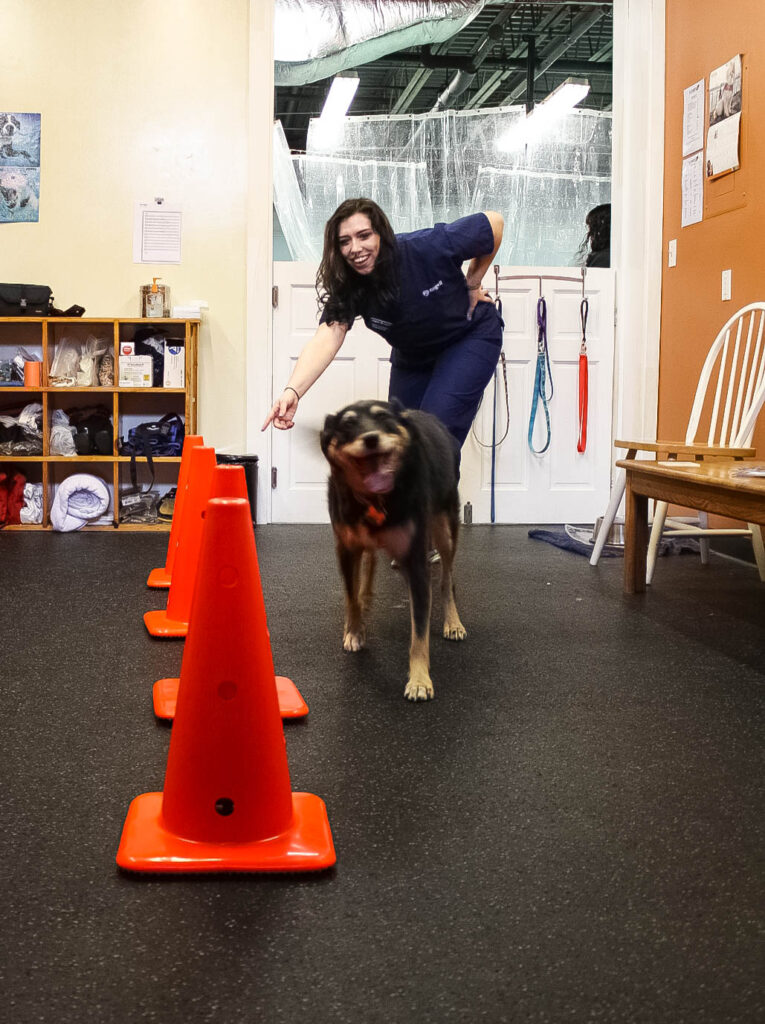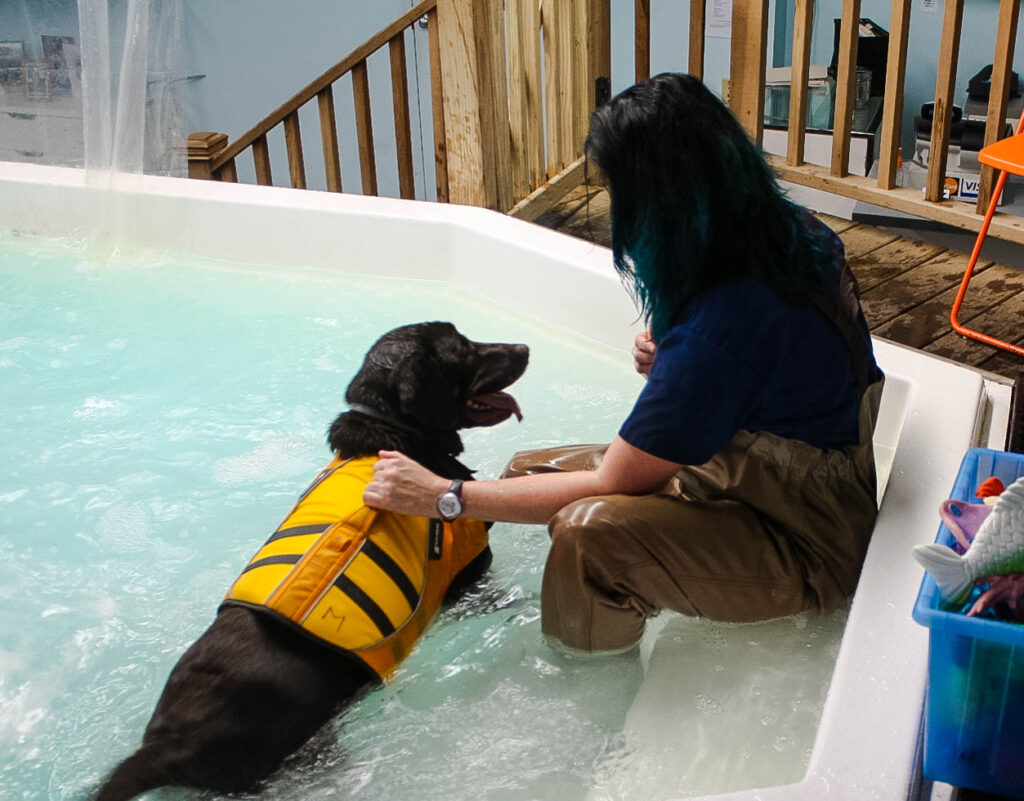-
Adopt
-
Veterinary Care
Services
Client Information
- What to Expect – Angell Boston
- Client Rights and Responsibilities
- Payments / Financial Assistance
- Pharmacy
- Client Policies
- Our Doctors
- Grief Support / Counseling
- Directions and Parking
- Helpful “How-to” Pet Care
Online Payments
Referrals
- Referral Forms/Contact
- Direct Connect
- Referring Veterinarian Portal
- Clinical Articles
- Partners in Care Newsletter
CE, Internships & Alumni Info
CE Seminar Schedule
Emergency: Boston
Emergency: Waltham
Poison Control Hotline
-
Programs & Resources
- Careers
-
Donate Now
Canine physical rehabilitation adapts techniques developed in the field of physical therapy for people to improve mobility, stability and overall function. It can reduce or eliminate pain, improve quality of life and facilitate recovery from a variety of orthopedic and neurological conditions. Typically, the sooner rehabilitation begins after injury or surgery, the better the outcome.
Candidates for physical rehabilitation include:
- Dogs who have had surgery to address an orthopedic or neurological condition
- Senior dogs who need to regain functional independence, such as negotiating stairs or getting into the car
- Canine athletes and working dogs seeking to recover after an injury, or trying to maintain that competitive edge
- Young dogs with a congenital (genetic) disorder, such as hip dysplasia
Owner Education

From the very first appointment, each Angell Physical Rehabilitation client has a home plan focusing on three aspects:
Your Dog’s Condition
We answer any questions you have, helping you fully understand and manage your dog’s condition and empowering you to participate actively in rehabilitation.
 Your Home Environment
Your Home Environment
We get to know you and form a detailed picture of your home environment. As appropriate, we will recommend simple, easy-to-implement changes to best support your dog’s needs.
Treatment You Can Provide
As needed, we will teach you simple hands-on techniques to massage and stretch your dog. We will also identify and teach you specific exercises your dog can perform at home. We know it can be difficult to add a new exercise regimen to your schedule. We can offer creative tips and tricks to incorporate specific skills and exercises into your dog’s existing routine.
Hydrotherapy
 Many of our physical rehabilitation clients use our pool as an important component of their rehabilitation. Swimming in a warm, controlled environment helps build strength and cardiovascular fitness, soothe aching joints, increase flexibility, and retrain healthy movement patterns.
Many of our physical rehabilitation clients use our pool as an important component of their rehabilitation. Swimming in a warm, controlled environment helps build strength and cardiovascular fitness, soothe aching joints, increase flexibility, and retrain healthy movement patterns.
Land-Based Exercise
 Our land-based exercises provide physical conditioning to increase strength, stamina, and muscle mass, as well as improvements in balance, agility, and confidence.
Our land-based exercises provide physical conditioning to increase strength, stamina, and muscle mass, as well as improvements in balance, agility, and confidence.
We use various pieces of equipment both indoors and outdoors, including:
- Cavaletti rails
- Assorted balancing tools
- Therapy balls and physio rolls
- Hula hoops
- BOSU
Check out Radar’s progress after the use of cavaletti and other land-based physical rehabilitation exercises.
We have the specialized equipment and training to provide specific, safe, and appropriate challenge for your dog. We create a unique program for each animal, and modify in response to your dog’s changing ability. Rehabilitation is an ongoing process, and we will also provide you with simple exercises you can do in your existing home environment to support the work done at Angell and help your dog progress between sessions.


Manual Rehabilitation
 Alongside visual and movement assessments, we perform hands-on assessment of your dog’s soft tissue flexibility and joint range of motion. We also palpate to assess muscle tone, quality of tissue, tenderness, temperature, and swelling.
Alongside visual and movement assessments, we perform hands-on assessment of your dog’s soft tissue flexibility and joint range of motion. We also palpate to assess muscle tone, quality of tissue, tenderness, temperature, and swelling.
While your dog is lying comfortably, we apply a variety of gentle yet effective soft tissue techniques to restore mobility, diminish swelling, and control pain. Techniques include:
- Joint mobilization
- Passive range of motion
- Stretching
- Myofascial release and other massage techniques
Therapeutic Laser
For dogs with joint pain, inflammation, muscle strains, and wounds.
 While the dog is lying comfortably, we part the fur and apply a laser light wand to the dog’s skin for approximately a few seconds per area treated. The number of areas treated, the frequency of light used, and duration of treatment all depends on your dog’s condition.
While the dog is lying comfortably, we part the fur and apply a laser light wand to the dog’s skin for approximately a few seconds per area treated. The number of areas treated, the frequency of light used, and duration of treatment all depends on your dog’s condition.
During treatment, the laser produces a series of beeps; there is no other sensation for your dog.
What makes the laser effect is the specific wavelength of light used. Similar to how a plant uses photosynthesis for growth and healing, the therapeutic laser uses a particular wavelength of light to penetrate tissue and promote healing. Specific benefits include reduced inflammation, improved circulation, and increased metabolism.
Consultation and Fitting of Assistive Devices

We pride ourselves on our depth of knowledge about the latest and best adaptive devices available to assist your pet in recovering from injury or managing long-term disability or age-related mobility issues. Most products are available on-site; as needed, we will assist you in ordering anything we do not carry.
We save you time and money by ensuring to the best of our abilities that you receive the right devices for your dog and ensuring the best fit for maximum comfort and effect. As needed, we work with your veterinarian.

Our service includes:
- Recommending the right assistive devices for your dog
- Helping you order products not always available to the general public
- Measuring for custom braces and orthotics
- Fitting your dog’s harness, sling, or mobility cart. Small adjustments can mean a world of difference in both comfort and effectiveness.
- Ensuring appropriate ongoing support as your dog’s condition evolves


